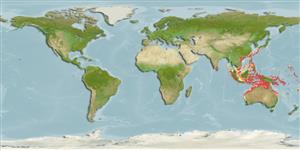Common names from other countries
>
Eupercaria/misc (Various families in series Eupercaria) >
Labridae (Wrasses) > Bodianinae
Etymology: Choerodon: Greek, choiros = a pig + odous = teeth (Ref. 45335); referrring to the prominent anterior canines of the species in this genus (Ref. 116605); zamboangae: Named for its type locality, Zamboanga, southern Philippines..
More on authors: Seale & Bean.
Environment: milieu / climate zone / depth range / distribution range
Ecologia
marinhas associadas(os) a recifes; intervalo de profundidade 25 - 60 m (Ref. 90102). Tropical
Indo-West Pacific: Philippines (Ref. 9710) to Indonesia and northwestern Australia. Possibly the male of Choerodon robustus (Ref. 9710).
Tamanho / Peso / Idade
Maturity: Lm ? range ? - ? cm
Max length : 45.0 cm TL macho/indeterminado; (Ref. 48636)
Espinhos dorsais (total) : 13; Raios dorsais (total) : 7; Espinhos anais: 3; Raios anais : 10. Body without a broad dark, pale-margined, oblique band on side; body bicoloured, dusky anterodorsally and pale posteroventrally, line of demarcation extending between base of first dorsal-fin spine and upper side of pectoral-fin base; a broad anteroventrally tapering reddish brown stripe covering dorsal half of side posterior to greenish brown anterodorsal portion of body; reddish brown area edged ventrally by yellow stripe. (Ref 9823)
Found on deep outer reef habitats; flat sandy or weedy areas. Rarely seen by diving and is usually caught on lines from deep water (Ref. 48636). Usually found solitary, in rubble bottoms near seaward reefs. C. melanostigma is a junior synonym (Ref. 90102).
Ciclo de vida ou comportamento de acasalamento
Maturities | Reprodução | Spawnings | Egg(s) | Fecundities | Larvas
Oviparous, distinct pairing during breeding (Ref. 205).
Sainsbury, K.J., P.J. Kailola and G.G. Leyland, 1985. Continental shelf fishes of the northern and north-western Australia. An illustrated guide. CSIRO Division of Fisheries Research; Clouston & Hall and Peter Pownall Fisheries Information Service, Canberra, Australia. 375 p. (Ref. 3131)
Status na Lista Vermelha da UICN (Ref. 130435)
CITES (Ref. 128078)
Not Evaluated
Ameaça para os humanos
Harmless
Uso pelos humanos
Ferramentas
Relatórios especiais
Baixar XML
Fontes da internet
Estimates based on models
Preferred temperature (Ref.
115969): 24.2 - 28.4, mean 27.2 (based on 101 cells).
Índice de diversidade filogenética (Ref.
82804): PD
50 = 0.5000 [Uniqueness, from 0.5 = low to 2.0 = high].
Bayesian length-weight: a=0.01318 (0.00582 - 0.02984), b=3.05 (2.86 - 3.24), in cm Total Length, based on LWR estimates for this (Sub)family-body shape (Ref.
93245).
Nível Trófico (Ref.
69278): 3.5 ±0.4 se; based on size and trophs of closest relatives
Resiliência (Ref.
120179): médio(a), tempo mínimo de duplicação da população 1,4 - 4,4 anos (Preliminary K or Fecundity.).
Fishing Vulnerability (Ref.
59153): Low to moderate vulnerability (35 of 100).
